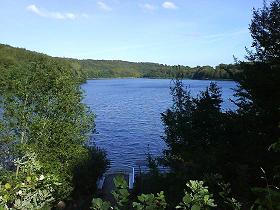Toteissee Ukleisee (Lake Uklei - A Death Ice Lake) EarthCache
Toteissee Ukleisee (Lake Uklei - A Death Ice Lake)
-
Difficulty:
-

-
Terrain:
-

Size:  (not chosen)
(not chosen)
Please note Use of geocaching.com services is subject to the terms and conditions
in our disclaimer.
 Please scroll downward for the english version.
Please scroll downward for the english version.
Der Ukleisee - ein Toteis-See
Unsere Landschaft hier in Schleswig-Holstein verdanken wir zum
größten Teil den vergangenen Eiszeiten. Ohne sie säßen fast alle
Schleswig-Holsteiner heute mit nassen Füßen im Meer.
Hier im östlichen Hügelland hat vor allem die letzte Eiszeit
(Weichseleiszeit) das Land geprägt. Wie ein großer Hobel haben sind
die Gletscher über das Land geschoben und dabei massenhaft Schutt
und Geröll mitgenommen. Als der Eisrand der Gletscherzungen dann
nach und nach zurück schmolz, blieben mehr oder weniger große Hügel
aus den Ablagerungen übrig (Grundmoränen, Endmoränen). Die Mulden
liefen mit Wasser voll und bildeten die Seen. Allerdings gilt
dieses Prinzip nicht für alle Seen. Zum Beispiel nicht für den
Ukleisee.

Der Ukleisee ist ein sogenannter Toteis-See. Echte Toteis-Seen gibt
es in Schleswig-Holstein einige, aber der Ukleisee ist
wahrscheinlich der Größte von ihnen.
Die kleinen Varianten eines Toteis-Sees sind Toteislöcher. Die
sieht man häufiger, wenn man mit offenen Augen durch die
eiszeitlich geprägte Landschaft fährt, z.B. wenn man mitten in
einem kultivierten Feld eine Art verwilderte Mulde mit einem Teich
(Söll) drin sieht.

Zur Entstehung dieser Toteislöcher: In einer tieferen Mulde bleibt
beim Zurückschmelzen einer Gletscherzunge ein riesiger Eisblock als
"Toteisblock" zurück. Dieser wird beim kompletten Abschmelzen des
Gletschers mit Sediment (Schutt, Geröll, Sand) vollständig bedeckt.
Durch diese isolierende Schicht hält ein Toteisblock viele hunderte
bis tausende Jahre. Mit dem Abschmelzen sackt das Sediment darüber
ein und es entsteht ein Toteisloch, das sich meist mit Grundwasser
füllt. Bei ganz großen Toteislöchern spricht man von Toteisseen.
Und hier die Frage zum Uklei-See: Wie kann man heute
erkennen, dass es sich um einen Toteissee handelt? (Kleiner Tipp:
Denkt an ein Toteisloch und stellt euch das einfach viel größer
vor).
Bitte schickt eure Antwort in Kurzform per Mail an
earthcache@pommesmitmajo.de
und dann erhaltet ihr die Logfreigabe. Im Betreff bitte
"Earth-Cache Ukleisee" schreiben.
Zusätzliche Aufgabe:
Ausnahmen bestätigen die Regel: Der Uklei-See hat einen Abfluss.
Suche ihn und mache ein Foto von dir und dem aktuellen
Pegelstand.

Lade das Foto zusammen mit deinem Log hoch (Logs ohne Foto müssen
leider gelöscht werden). Trage den Wert des aktuellen Pegelstandes
in Zentimetern mit in dein Log ein!
Viel Spaß!





Lake Uklei - A Death Ice Lake
Our landscape here in Schleswig-Holstein is for most parts due to
the last glacial period. Without it most of the habitants would
nowadays stand in the sea having wet feet.
The eastern hill country here was mainly shaped by the last ice age
(Weichsel ice age). The glaciers moved just like huge planers over
the land taking masses of boulders with them. When the glacier
tongues melted more or less big hills remained (ground moraines,
end moraines). The dells filled with water became lakes. But this
principle is not valid for all the lakes. Such as the lake Uklei.

The lake Uklei is a so called "death ice lake". There are many real
death ice lakes in Schleswig-Holstein, but the lake Uklei is
probably the biggest of them. The small version of a death ice lake
is a death ice hole. You can see many of them going around the
glacial landscape keeping the eyes peeled.

To the genesis: In a deeper dell a huge death ice block is left
while the glacier tounge is melting away. In the process of melting
boulders cover the ice block. With this isolating layer the ice
block last hundreds to thousands of years. When it finally melts
the boulders sink to the ground forming a death ice hole which
fills with ground water. Very large death ice holes are called
death ice lakes.
And here for the question concerning the lake Uklei: How
could you nowadays recognize that a lake like the lake Uklei is
about a death ice lake? (Little hint: think of a death ice hole and
imagine it much more bigger)
Please send the answer in brief form to
earthcache@pommesmitmajo.de
and you'll get the release for your log. Please write in the
reference line: "Earth Cache Lake Uklei"
Additional challenge:
The exception proves the rule: The lake Uklei has got a small
outflow. Find it and take a photograph showing you and the current
water gauge.

Also post the water gauge (in centimeter) with your log (sorry, but
logs without photographs would be deleted automatically).
Have a nice time!

Additional Hints
(No hints available.)